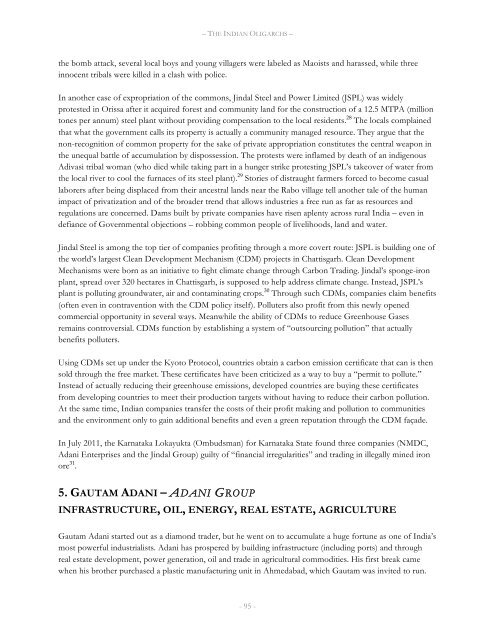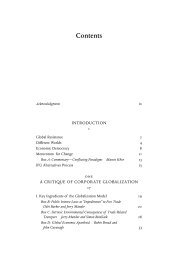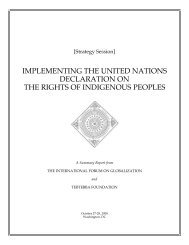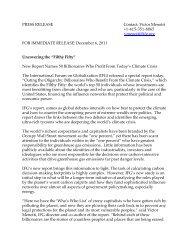Outing the Oligarchy - International Forum on Globalization
Outing the Oligarchy - International Forum on Globalization
Outing the Oligarchy - International Forum on Globalization
Create successful ePaper yourself
Turn your PDF publications into a flip-book with our unique Google optimized e-Paper software.
– THE INDIAN OLIGARCHS –<br />
<str<strong>on</strong>g>the</str<strong>on</strong>g> bomb attack, several local boys and young villagers were labeled as Maoists and harassed, while three<br />
innocent tribals were killed in a clash with police.<br />
In ano<str<strong>on</strong>g>the</str<strong>on</strong>g>r case of expropriati<strong>on</strong> of <str<strong>on</strong>g>the</str<strong>on</strong>g> comm<strong>on</strong>s, Jindal Steel and Power Limited (JSPL) was widely<br />
protested in Orissa after it acquired forest and community land for <str<strong>on</strong>g>the</str<strong>on</strong>g> c<strong>on</strong>structi<strong>on</strong> of a 12.5 MTPA (milli<strong>on</strong><br />
t<strong>on</strong>es per annum) steel plant without providing compensati<strong>on</strong> to <str<strong>on</strong>g>the</str<strong>on</strong>g> local residents. 28 The locals complained<br />
that what <str<strong>on</strong>g>the</str<strong>on</strong>g> government calls its property is actually a community managed resource. They argue that <str<strong>on</strong>g>the</str<strong>on</strong>g><br />
n<strong>on</strong>-recogniti<strong>on</strong> of comm<strong>on</strong> property for <str<strong>on</strong>g>the</str<strong>on</strong>g> sake of private appropriati<strong>on</strong> c<strong>on</strong>stitutes <str<strong>on</strong>g>the</str<strong>on</strong>g> central weap<strong>on</strong> in<br />
<str<strong>on</strong>g>the</str<strong>on</strong>g> unequal battle of accumulati<strong>on</strong> by dispossessi<strong>on</strong>. The protests were inflamed by death of an indigenous<br />
Adivasi tribal woman (who died while taking part in a hunger strike protesting JSPL’s takeover of water from<br />
<str<strong>on</strong>g>the</str<strong>on</strong>g> local river to cool <str<strong>on</strong>g>the</str<strong>on</strong>g> furnaces of its steel plant). 29 Stories of distraught farmers forced to become casual<br />
laborers after being displaced from <str<strong>on</strong>g>the</str<strong>on</strong>g>ir ancestral lands near <str<strong>on</strong>g>the</str<strong>on</strong>g> Rabo village tell ano<str<strong>on</strong>g>the</str<strong>on</strong>g>r tale of <str<strong>on</strong>g>the</str<strong>on</strong>g> human<br />
impact of privatizati<strong>on</strong> and of <str<strong>on</strong>g>the</str<strong>on</strong>g> broader trend that allows industries a free run as far as resources and<br />
regulati<strong>on</strong>s are c<strong>on</strong>cerned. Dams built by private companies have risen aplenty across rural India – even in<br />
defiance of Governmental objecti<strong>on</strong>s – robbing comm<strong>on</strong> people of livelihoods, land and water.<br />
Jindal Steel is am<strong>on</strong>g <str<strong>on</strong>g>the</str<strong>on</strong>g> top tier of companies profiting through a more covert route: JSPL is building <strong>on</strong>e of<br />
<str<strong>on</strong>g>the</str<strong>on</strong>g> world’s largest Clean Development Mechanism (CDM) projects in Chattisgarh. Clean Development<br />
Mechanisms were born as an initiative to fight climate change through Carb<strong>on</strong> Trading. Jindal’s sp<strong>on</strong>ge-ir<strong>on</strong><br />
plant, spread over 320 hectares in Chattisgarh, is supposed to help address climate change. Instead, JSPL’s<br />
plant is polluting groundwater, air and c<strong>on</strong>taminating crops. 30 Through such CDMs, companies claim benefits<br />
(often even in c<strong>on</strong>traventi<strong>on</strong> with <str<strong>on</strong>g>the</str<strong>on</strong>g> CDM policy itself). Polluters also profit from this newly opened<br />
commercial opportunity in several ways. Meanwhile <str<strong>on</strong>g>the</str<strong>on</strong>g> ability of CDMs to reduce Greenhouse Gases<br />
remains c<strong>on</strong>troversial. CDMs functi<strong>on</strong> by establishing a system of “outsourcing polluti<strong>on</strong>” that actually<br />
benefits polluters.<br />
Using CDMs set up under <str<strong>on</strong>g>the</str<strong>on</strong>g> Kyoto Protocol, countries obtain a carb<strong>on</strong> emissi<strong>on</strong> certificate that can is <str<strong>on</strong>g>the</str<strong>on</strong>g>n<br />
sold through <str<strong>on</strong>g>the</str<strong>on</strong>g> free market. These certificates have been criticized as a way to buy a “permit to pollute.”<br />
Instead of actually reducing <str<strong>on</strong>g>the</str<strong>on</strong>g>ir greenhouse emissi<strong>on</strong>s, developed countries are buying <str<strong>on</strong>g>the</str<strong>on</strong>g>se certificates<br />
from developing countries to meet <str<strong>on</strong>g>the</str<strong>on</strong>g>ir producti<strong>on</strong> targets without having to reduce <str<strong>on</strong>g>the</str<strong>on</strong>g>ir carb<strong>on</strong> polluti<strong>on</strong>.<br />
At <str<strong>on</strong>g>the</str<strong>on</strong>g> same time, Indian companies transfer <str<strong>on</strong>g>the</str<strong>on</strong>g> costs of <str<strong>on</strong>g>the</str<strong>on</strong>g>ir profit making and polluti<strong>on</strong> to communities<br />
and <str<strong>on</strong>g>the</str<strong>on</strong>g> envir<strong>on</strong>ment <strong>on</strong>ly to gain additi<strong>on</strong>al benefits and even a green reputati<strong>on</strong> through <str<strong>on</strong>g>the</str<strong>on</strong>g> CDM façade.<br />
In July 2011, <str<strong>on</strong>g>the</str<strong>on</strong>g> Karnataka Lokayukta (Ombudsman) for Karnataka State found three companies (NMDC,<br />
Adani Enterprises and <str<strong>on</strong>g>the</str<strong>on</strong>g> Jindal Group) guilty of “financial irregularities” and trading in illegally mined ir<strong>on</strong><br />
ore 31 .<br />
5. GAUTAM ADANI – ADANI GROUP<br />
INFRASTRUCTURE, OIL, ENERGY, REAL ESTATE, AGRICULTURE<br />
Gautam Adani started out as a diam<strong>on</strong>d trader, but he went <strong>on</strong> to accumulate a huge fortune as <strong>on</strong>e of India’s<br />
most powerful industrialists. Adani has prospered by building infrastructure (including ports) and through<br />
real estate development, power generati<strong>on</strong>, oil and trade in agricultural commodities. His first break came<br />
when his bro<str<strong>on</strong>g>the</str<strong>on</strong>g>r purchased a plastic manufacturing unit in Ahmedabad, which Gautam was invited to run.<br />
- 95 -







